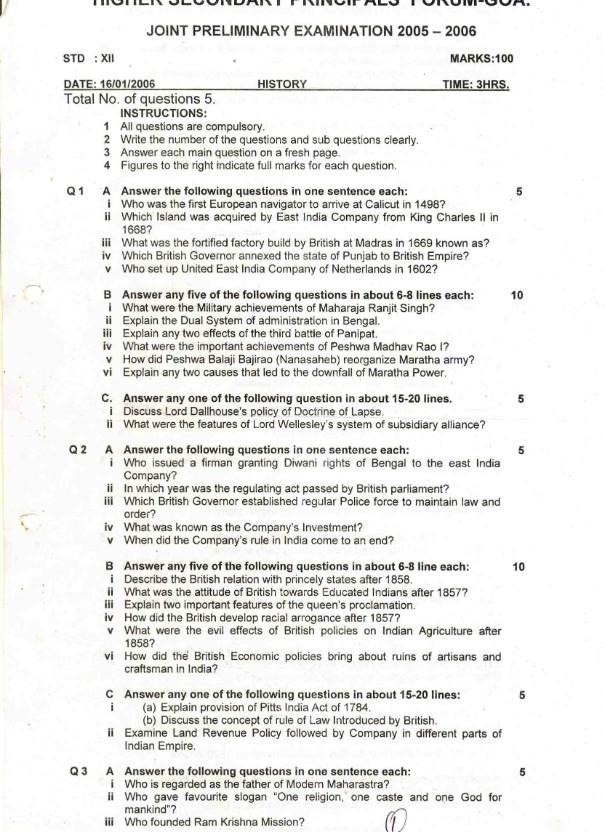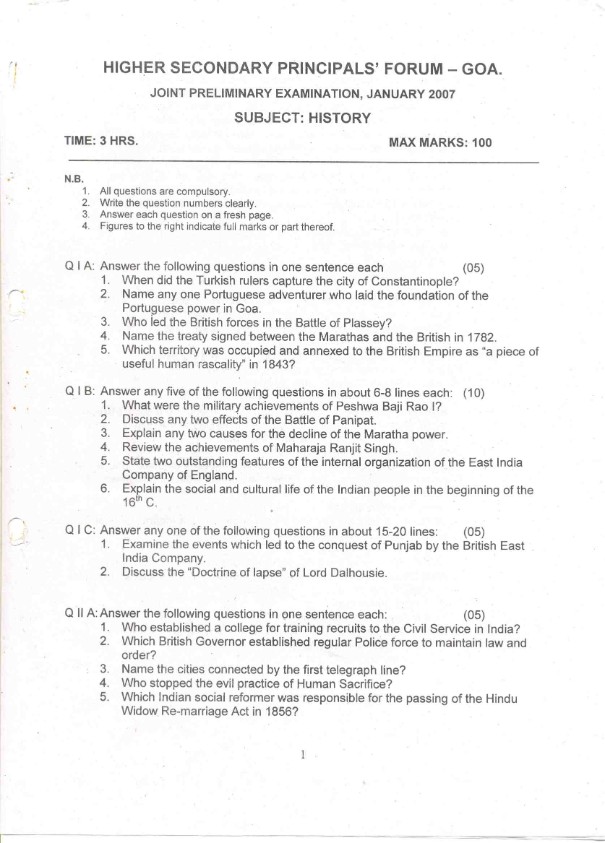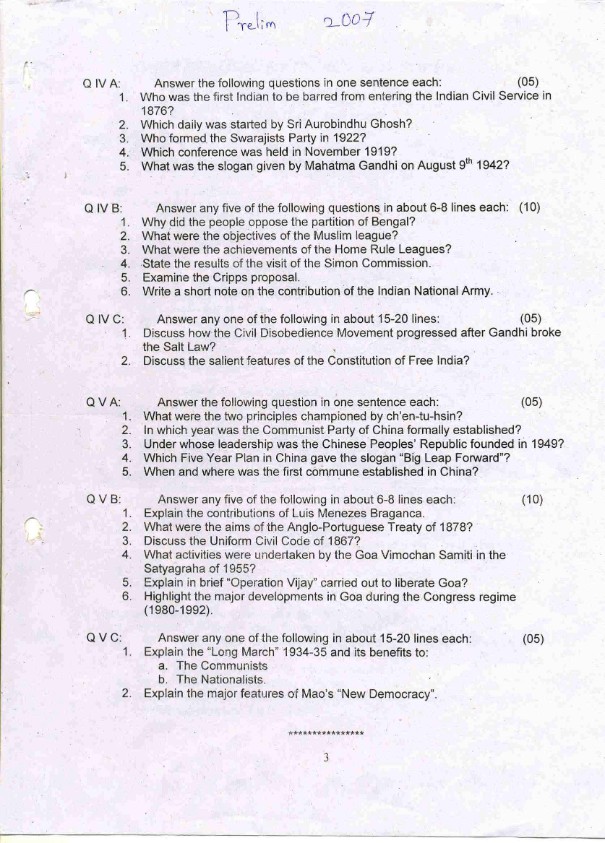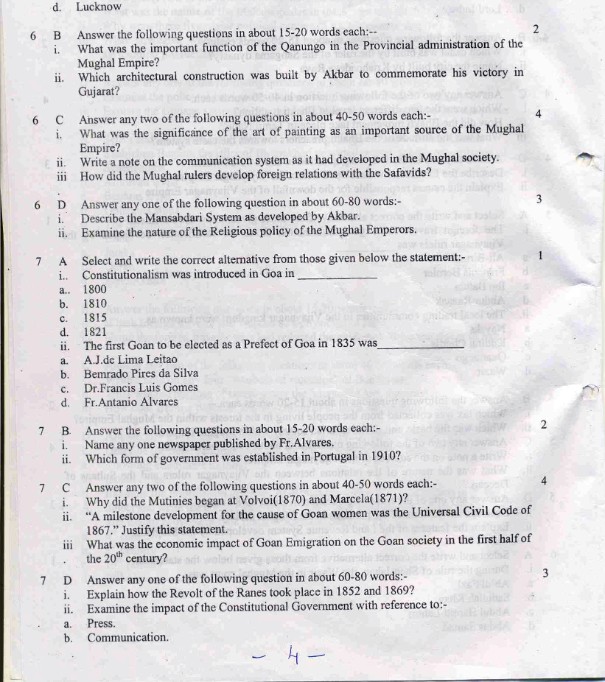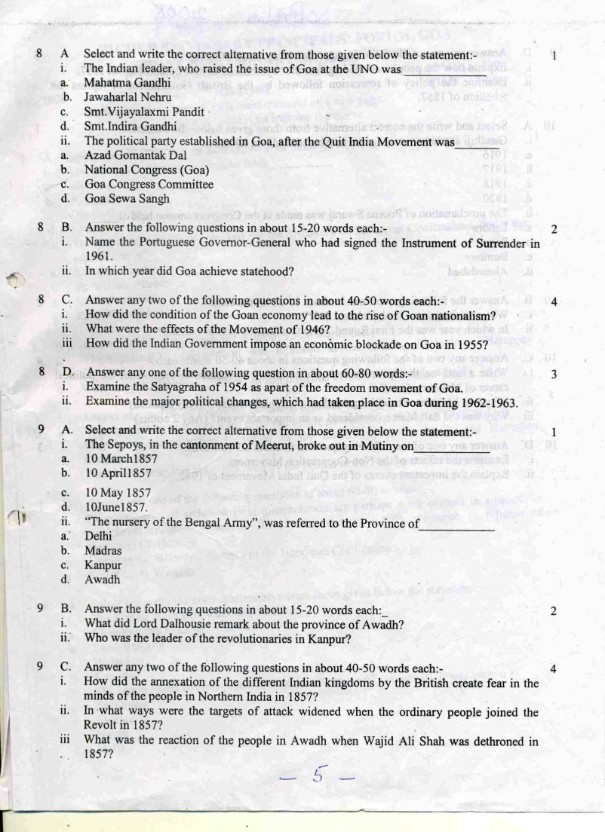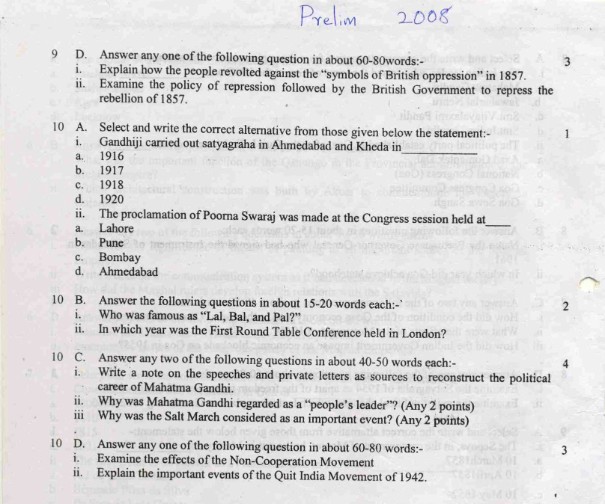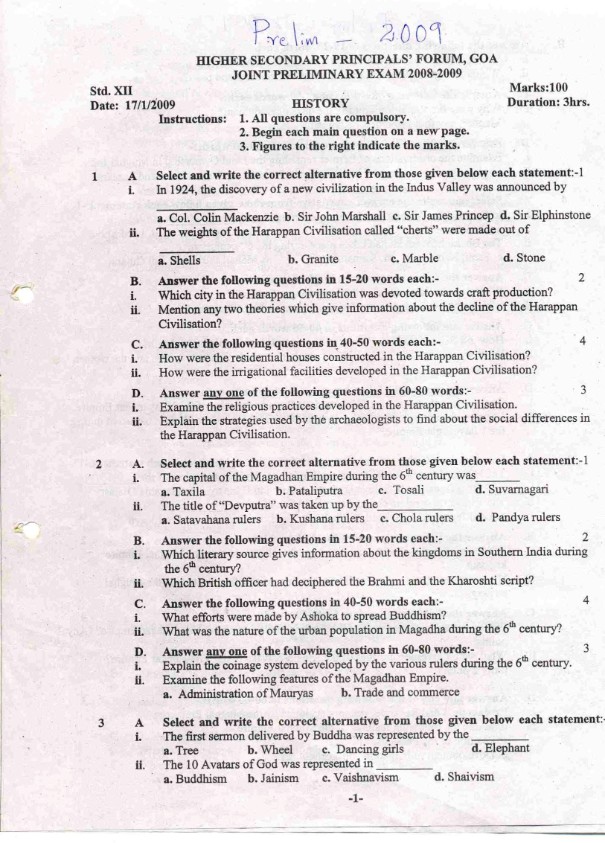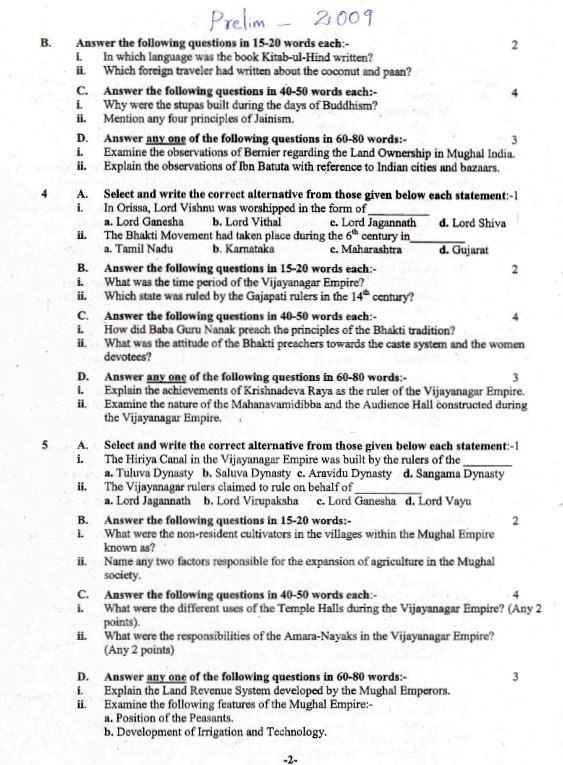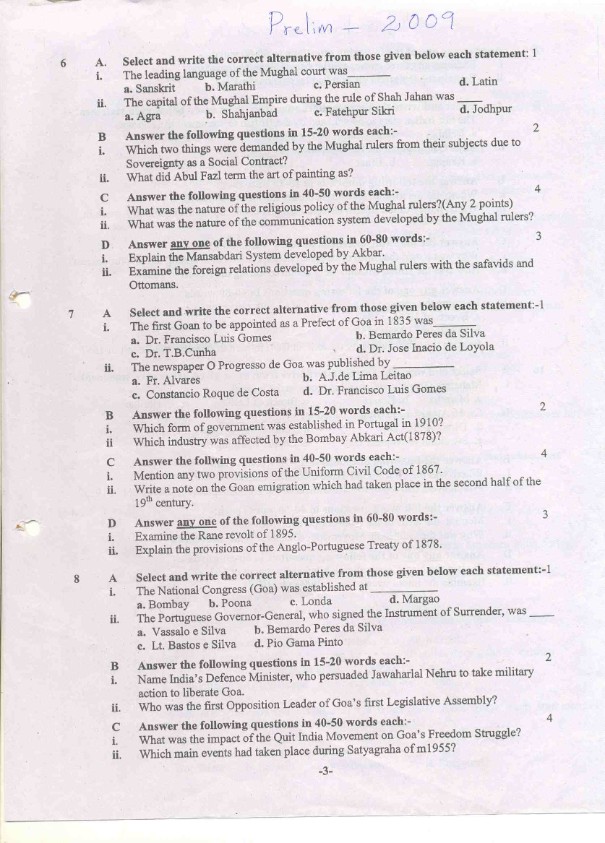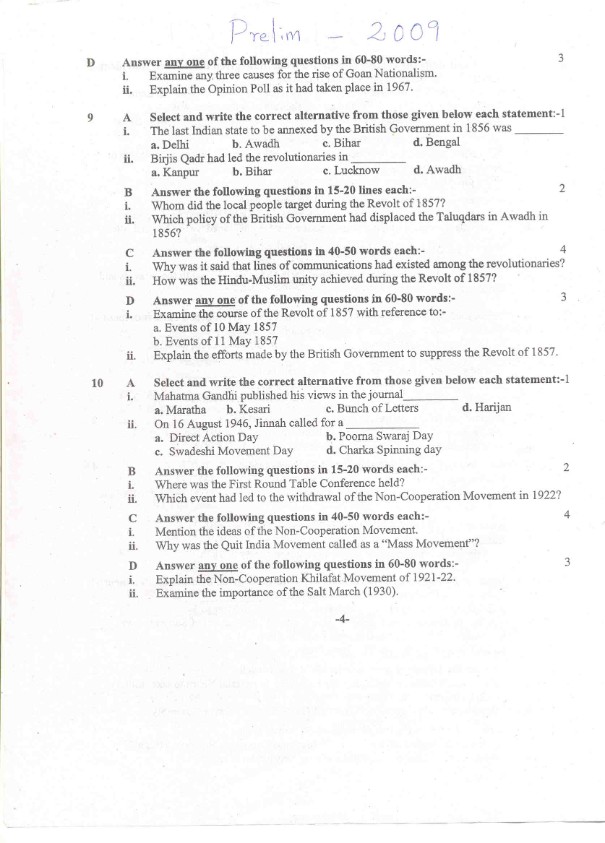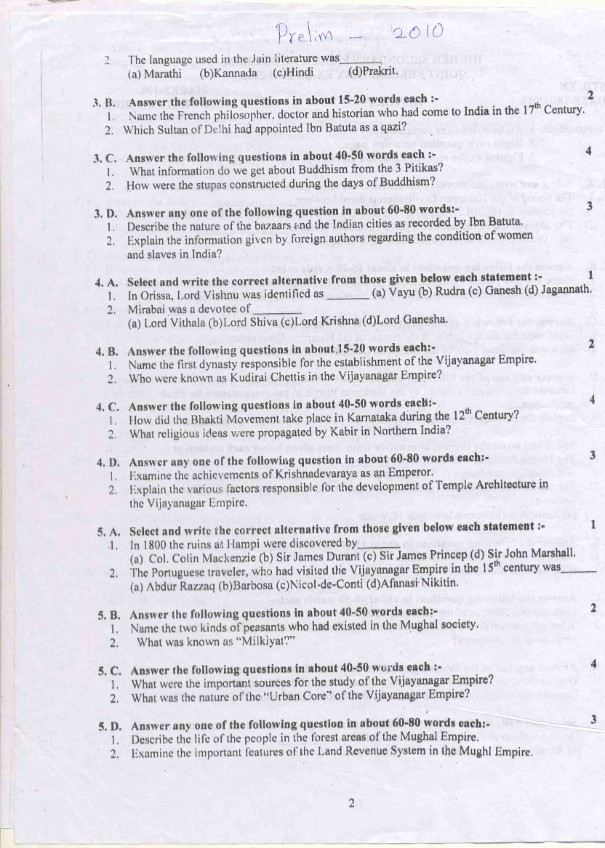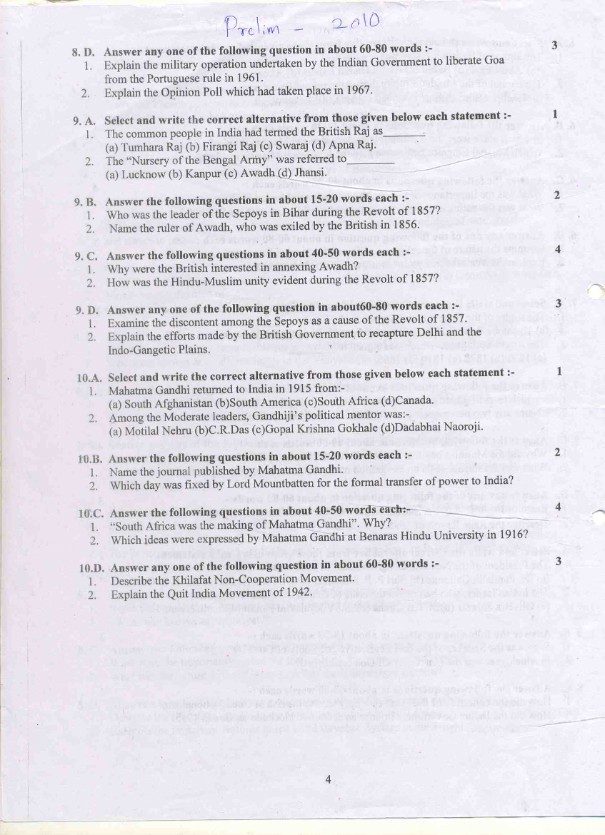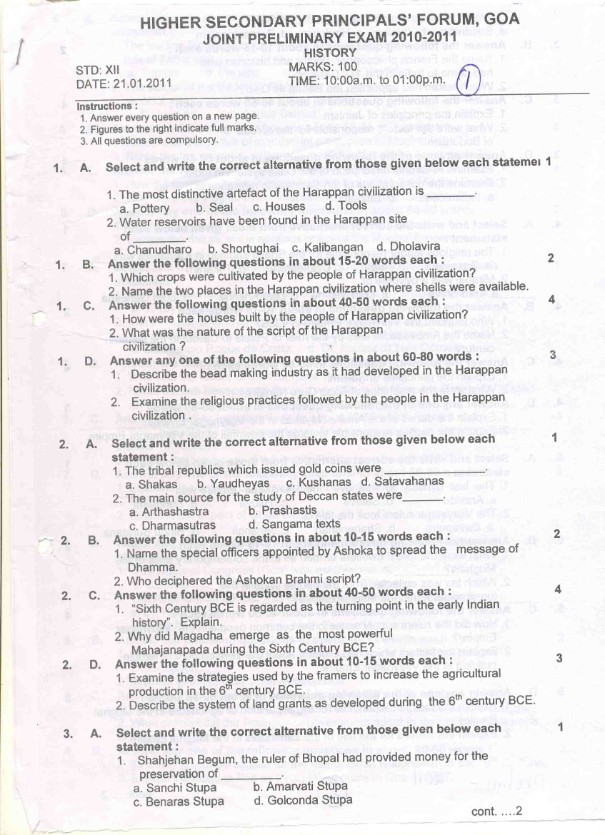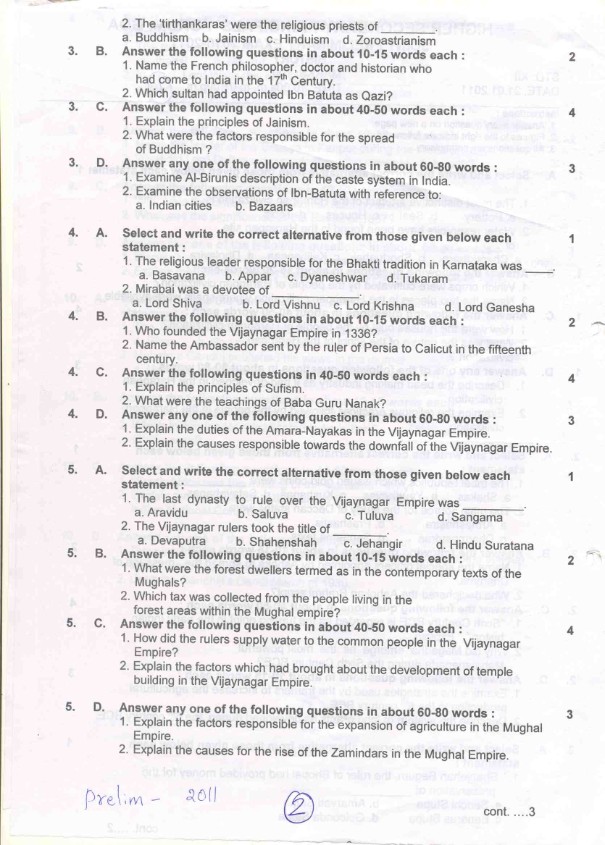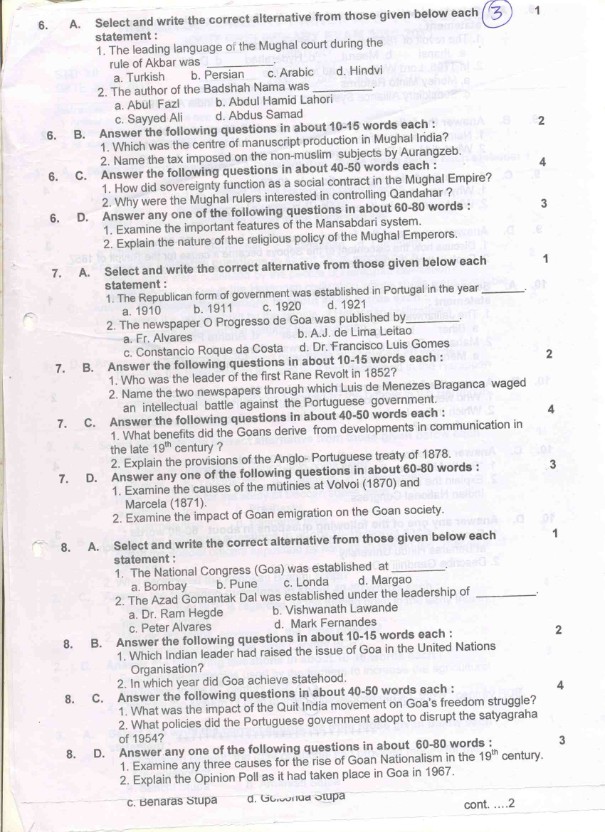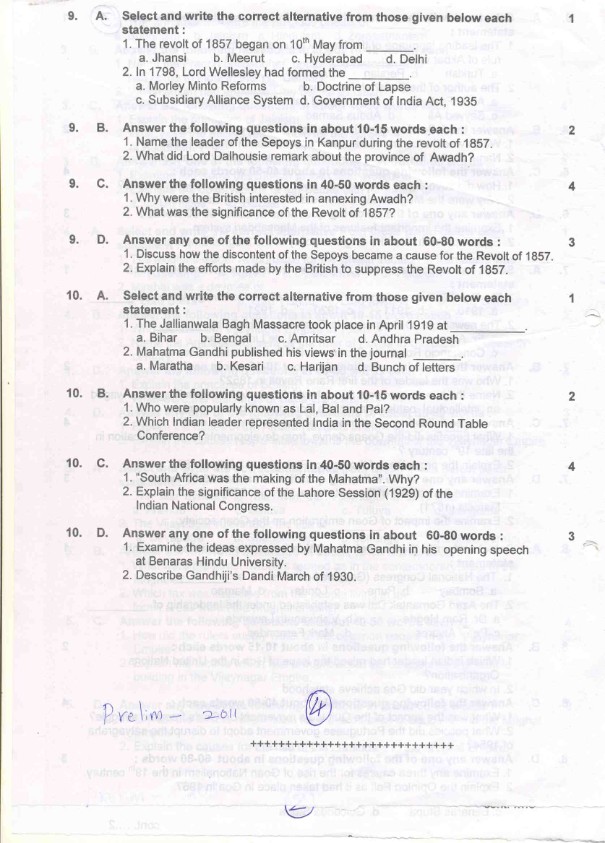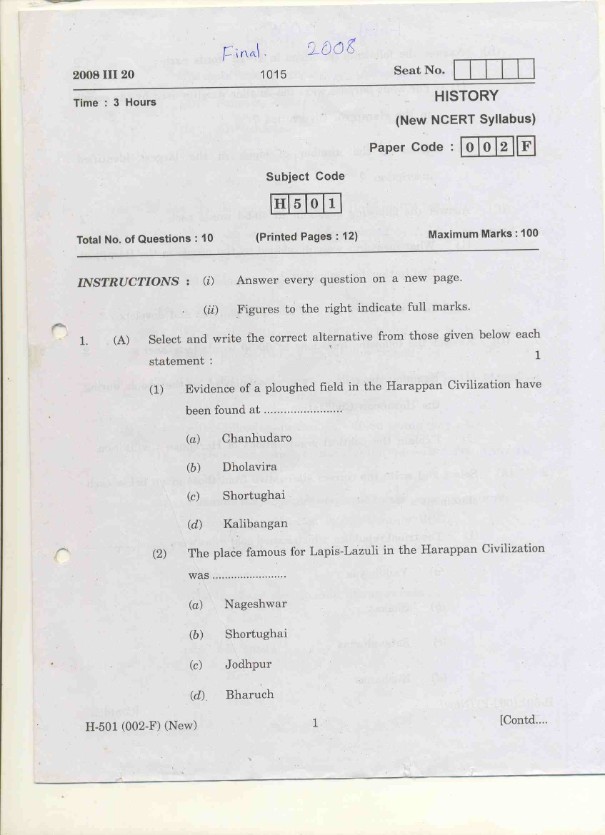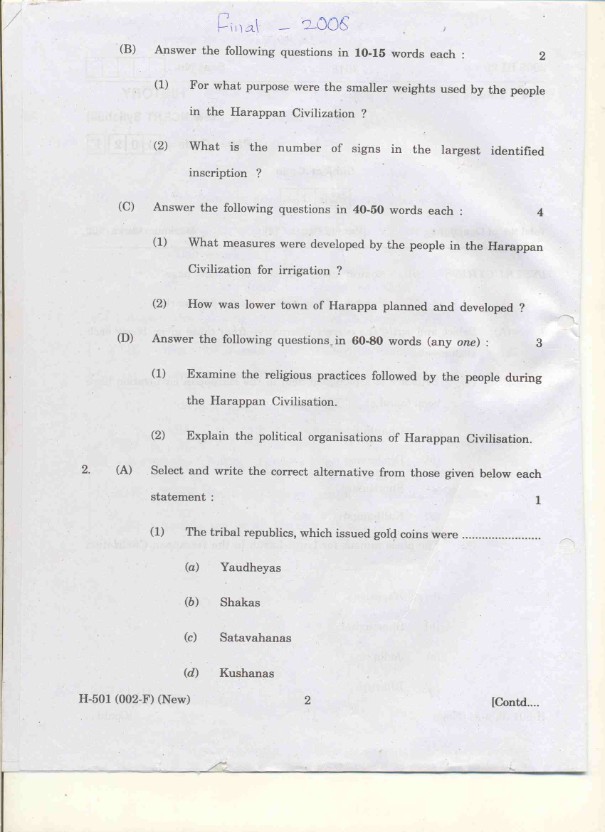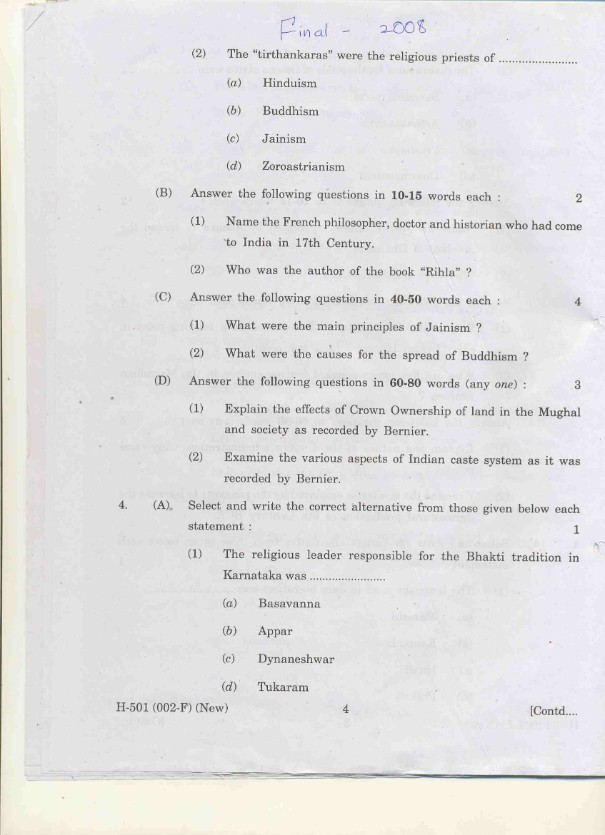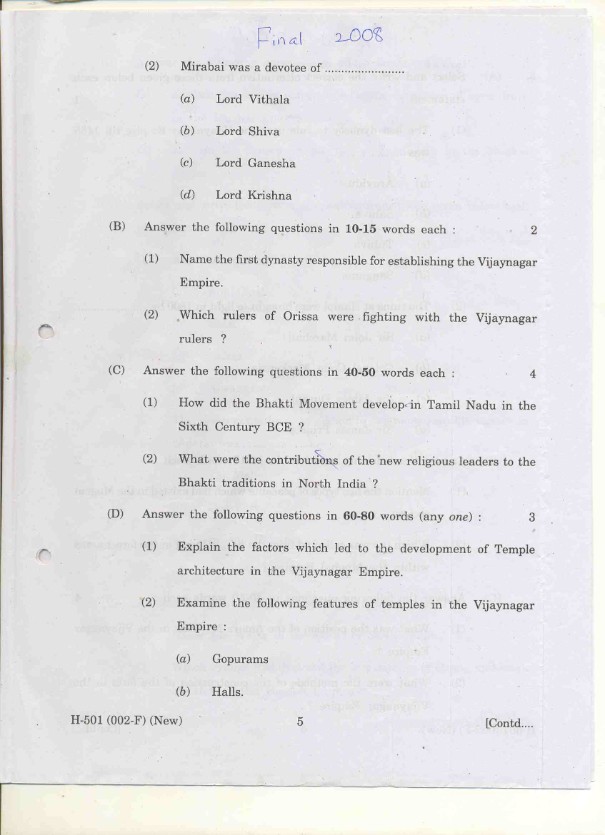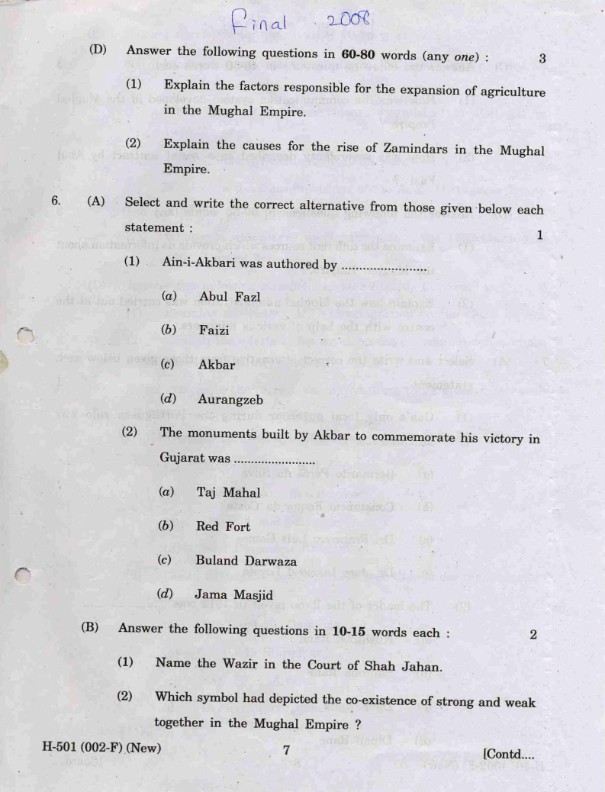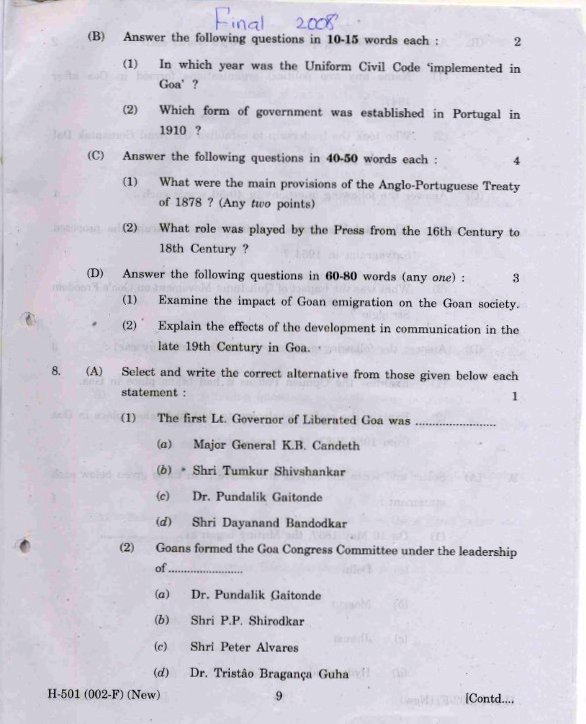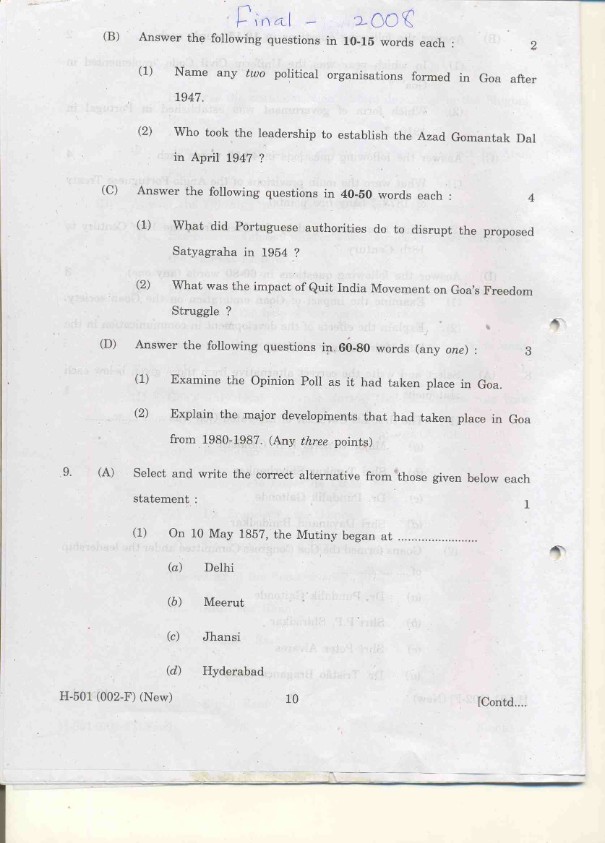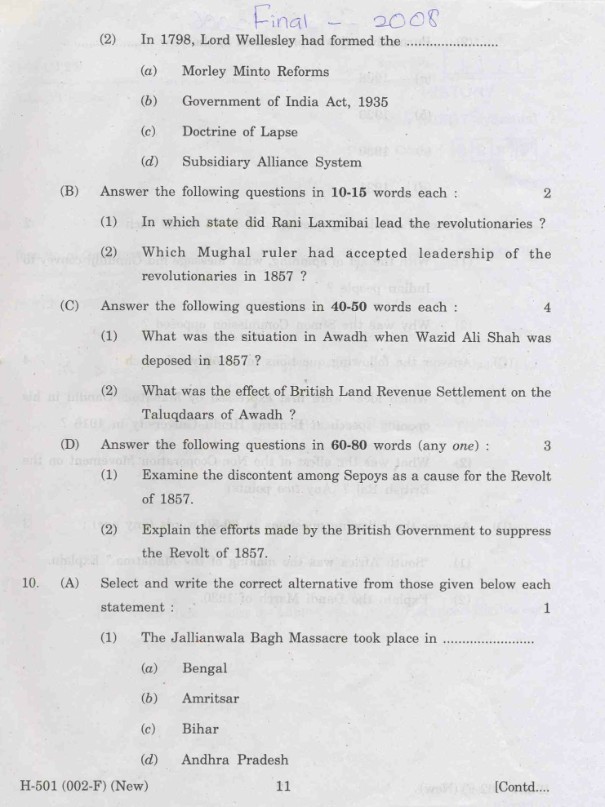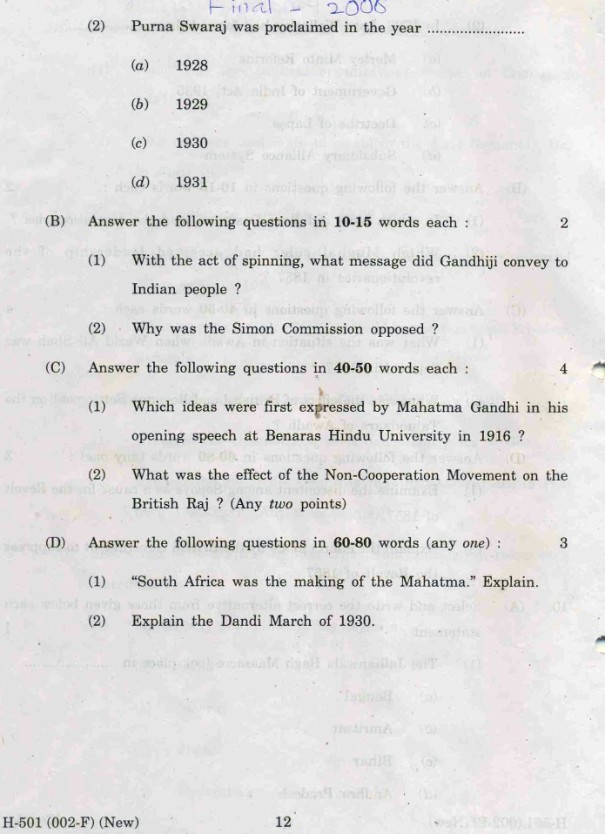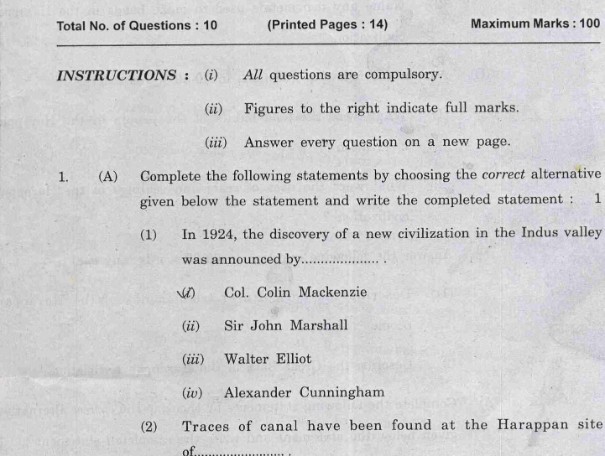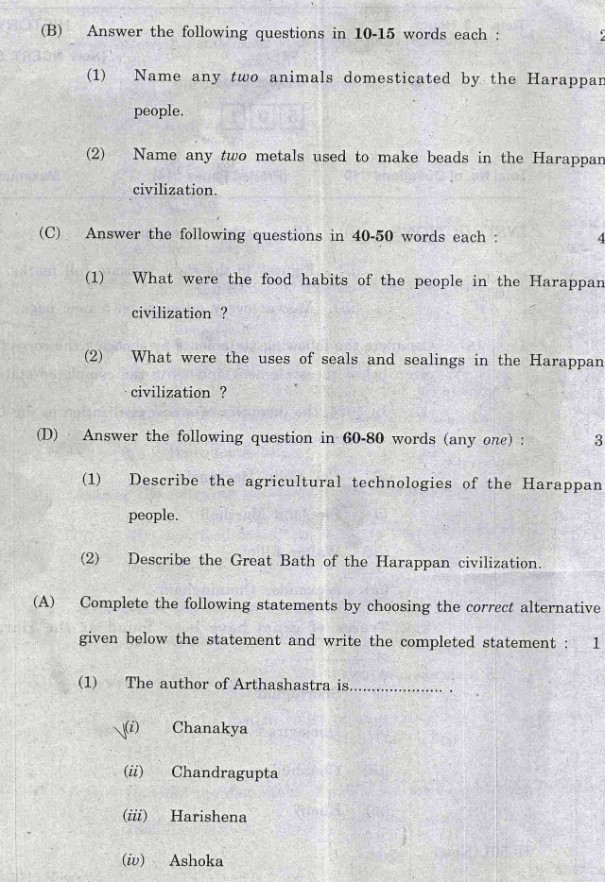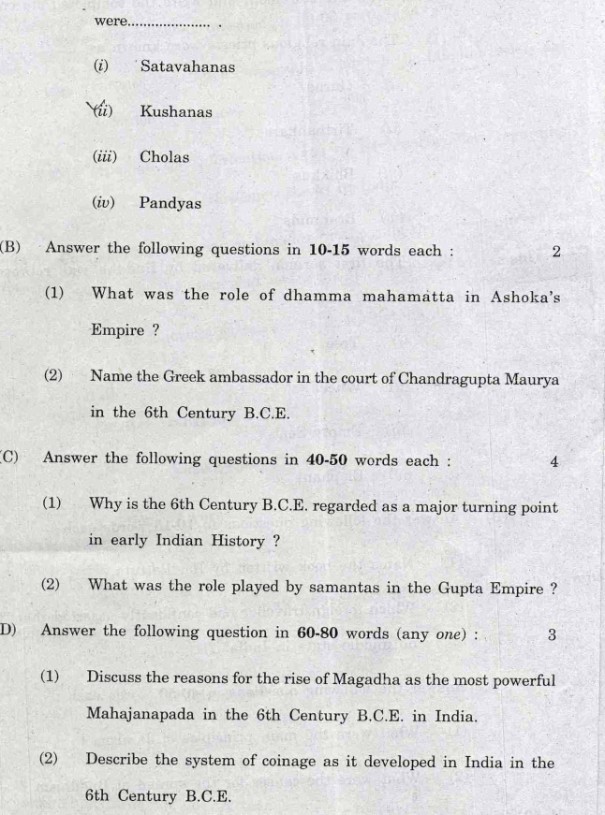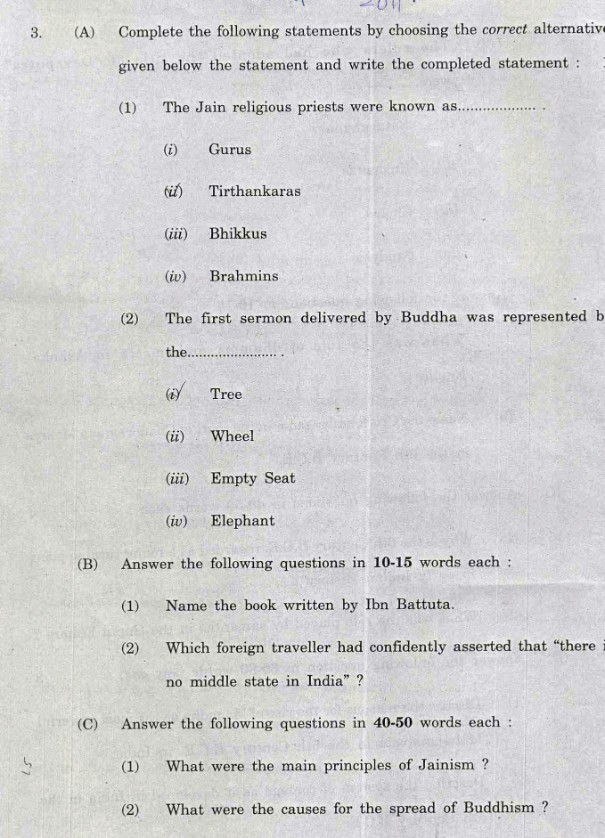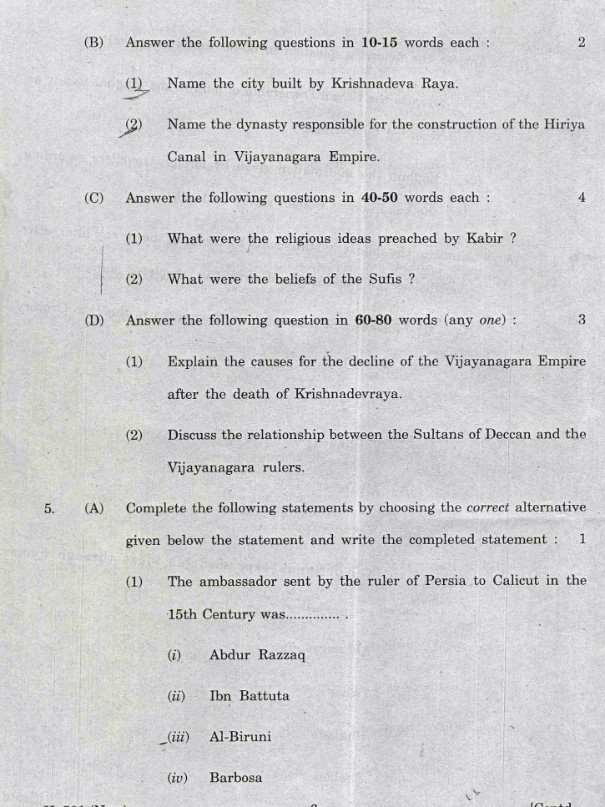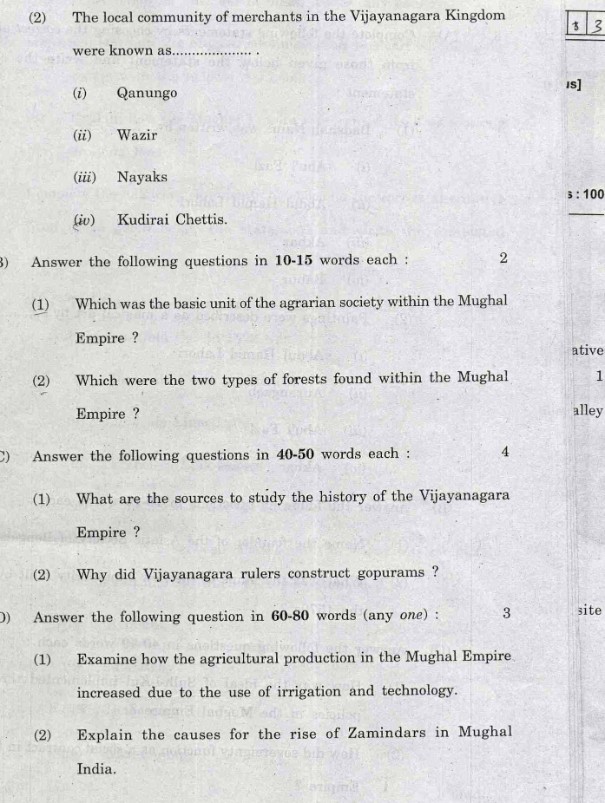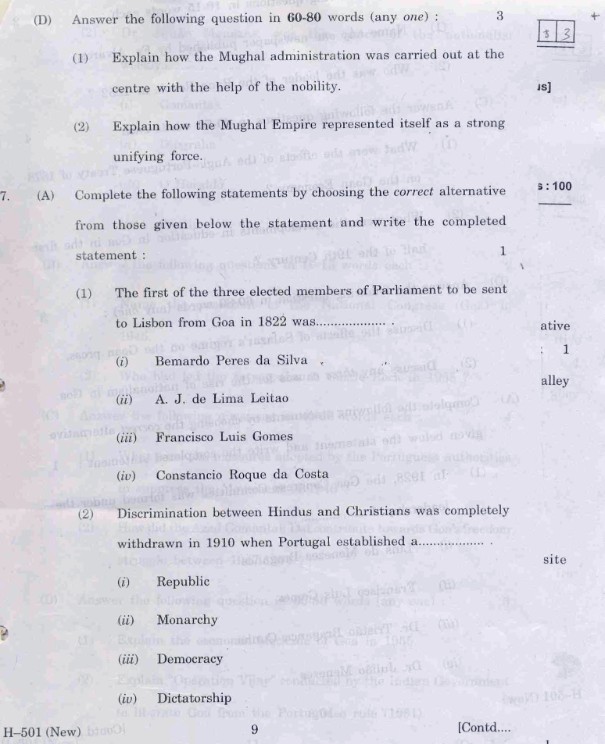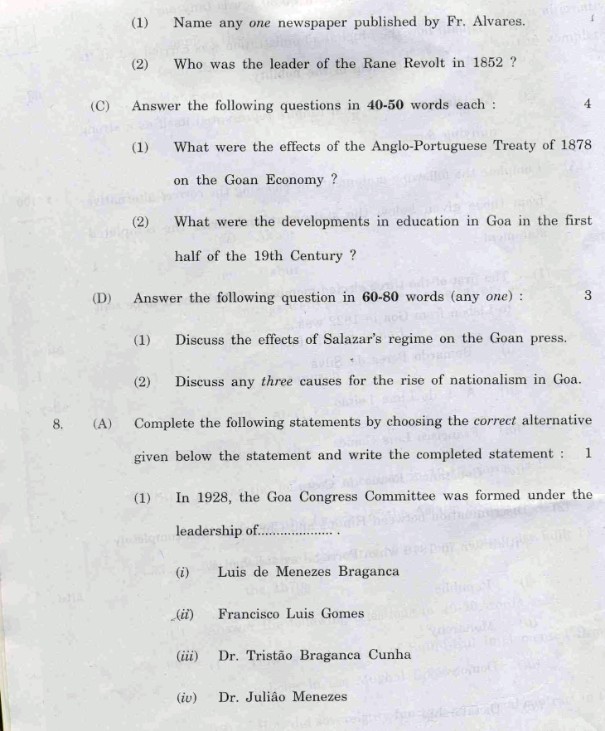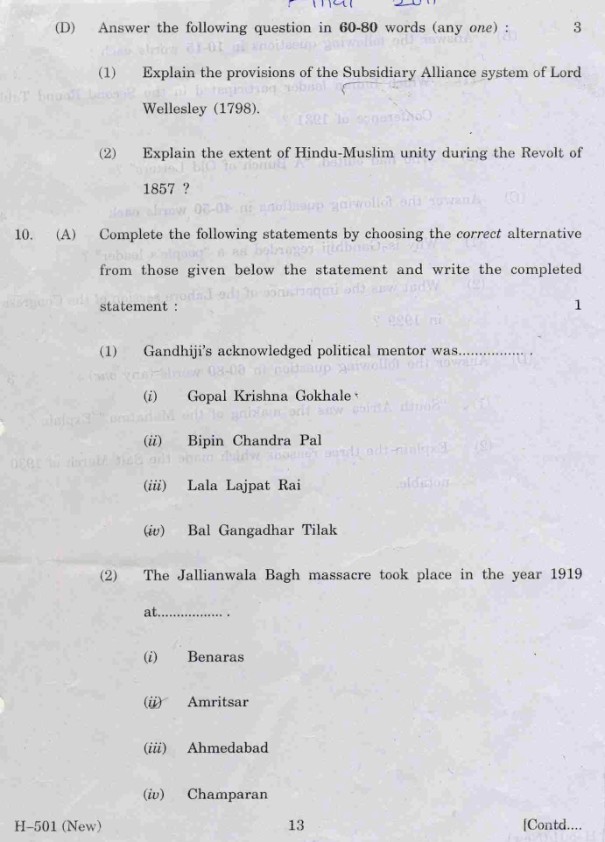

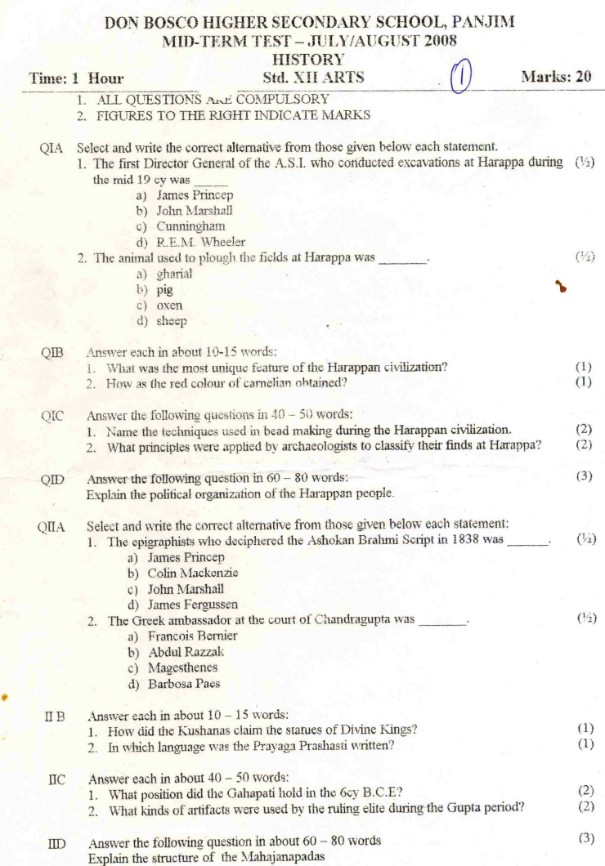
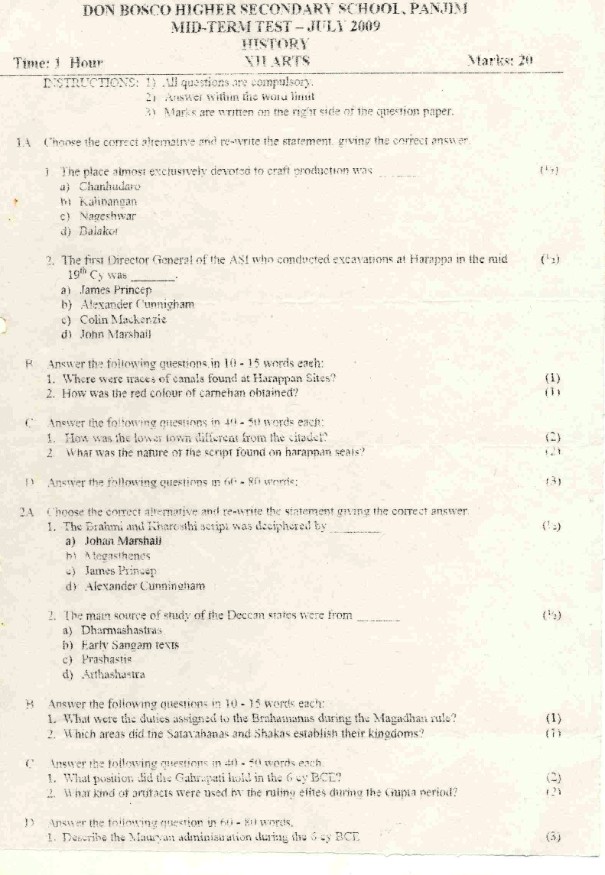
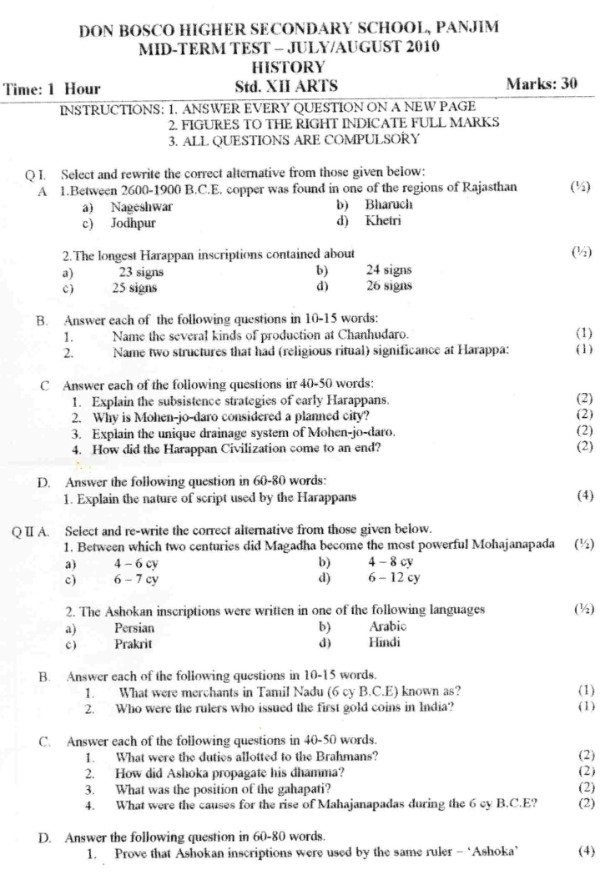

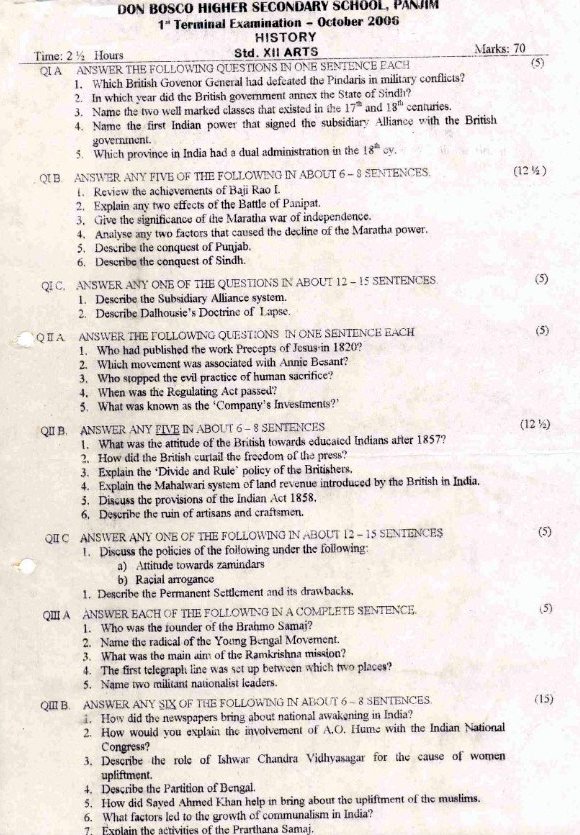


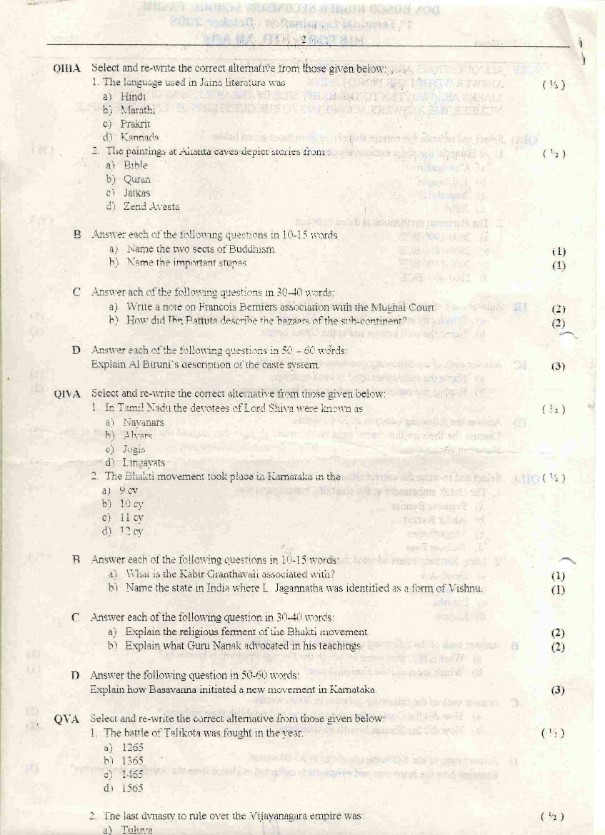




Terminal-1
DON BOSCO HIGHER SECONDARY SCHOOL, PANJIM
1st Terminal Examination – October 2010
Time: 3 Hours HISTORY Marks: 90
STD. XII ARTS
|
|
NOTE: |
| |||||||
|
|
1. All questions are compulsory. 2. Internal options are given in question No. D 3. Marks are written to the right side of the question paper 4. Answer within the word limits. 5. Write neatly. |
| |||||||
|
|
|
| |||||||
|
IA |
Select and re-write the correct alternative from those given below: |
( ½) | |||||||
|
|
1. The Harappan Civilization is dated between |
| |||||||
|
|
a) 2600-1900 B.C.E. b) 2500-1800 BCE |
c) 2000-1500 BCE d) 2100-400 BCE |
| ||||||
|
|
|
| |||||||
|
|
2. Terracotta models of the plough have been found at sites in |
( ½) | |||||||
|
|
a) Punjab b) Sindh |
c) Cholistan d) Afghanistan |
| ||||||
|
|
|
| |||||||
|
B |
Answer each of the following questions in 10 -15 words. |
| |||||||
|
|
1. Name the kinds of grains found at Harappa. 2. Name the place in Gujrat where water reservoirs have been found. 3. What methods were used by Harappans in writing the script. |
(1) (1) (1) | |||||||
|
|
|
| |||||||
|
C |
Answer each of the following questions in about 40 – 50 words. |
| |||||||
|
|
1. What methods were used by Harappans for bead making. 2. Explain the drainage system at Mohenjodaro. 3. What contacts did Harappans have with foreign countries for obtaining metals? 4. What principles were applied by Harappans to classify their finds at Harappa? |
(2) (2) (2) (2) | |||||||
|
|
|
| |||||||
|
D |
Answer one of the following questions in 60 – 80 words. |
| |||||||
|
|
1. Explain the agriculture technologies used by the Harappans. |
| |||||||
|
|
OR |
| |||||||
|
|
Explain the construction and use of the Great Bath. |
(3) | |||||||
|
|
|
| |||||||
|
IIA |
Select and re-write the correct alternative from those given below. |
| |||||||
|
|
1. The Prayaga Prashasti was composed by |
| |||||||
|
|
a) Harishena b) Kushana |
c) Ashoka d) Samudragupta |
( ½) | ||||||
|
|
|
| |||||||
|
|
2. Harishena was the court poet of _____ |
( ½) | |||||||
|
|
a) Chandragupta b) Ashoka |
c) Samudragupta d) Krishnadevaraya |
| ||||||
|
|
|
| |||||||
|
B |
Answer each of the following questions in 10 – 15 words. |
| |||||||
|
|
1. Name four of the important Mahajanapadas. 2. Name two religious leaders of the 6 cy BCE who belonged to the ganas. 3. Name the capital cities of Magadha |
(1) (1) (1) | |||||||
|
|
|
| |||||||
|
C |
Answer each of the following questions in about 40 -50 words. |
| |||||||
|
|
1. Name the structure of the Mahajanapados.. 2. Explain the sources that give us information on the Gupta rulers. 3. What were the religious principles that Ashoka tried to propagate? 4. Write a note on the sources that give us insights on the Mauryan empire. |
(2) (2) (2) (2) | |||||||
|
|
|
| |||||||
|
|
|
| |||||||
|
D |
Answer one of the following questions in 60-80 words: |
| |||||||
|
|
1. Explain the strategies used by the farmers to increase agricultural production in the Mahajanapadas. |
| |||||||
|
|
OR |
| |||||||
|
|
Explain the policy of hand grants followed by the rulers in the 6 cy BCE (3 pts) |
(3) | |||||||
|
|
|
| |||||||
|
IIIA |
Select and re-write the correct alternative from those given below: |
| |||||||
|
|
1. Buddhist teachings have been constructed from the stories found in _________. |
( ½) | |||||||
|
|
a) Vinaya pitaka b) Dipavamsa |
c) Sutta pitaka d) Tirthankaras |
| ||||||
|
|
|
| |||||||
|
|
2. The paintings at Ajanta depict stories from |
( ½) | |||||||
|
|
a) Bible b) Quran |
c) Jatakas d) Zend Avesta |
| ||||||
|
|
|
| |||||||
|
B |
Answer each of the following questions in 10 -15 words. |
| |||||||
|
|
1. Name the sources from where historians collected information about the cultural developments between 600 CE to 600 BCE. 2. In which language was the book Rihla written? 3. Name the Sultan of Delhi who lured Ibn Batutta to visit the place. 4. Name the traveller who reduced the existence of female slaves in India |
(1)
(1) (1) (1) | |||||||
|
|
|
| |||||||
|
C |
Answer each of the following questions in about 40 – 50 words. |
| |||||||
|
|
1. What was the unique features of temple building during the 600 BCE. 2. Write a note on the principles of Jainsim. 3. Write a note on Ibn Batutta travel experiences in India. |
(2) (2) (2) | |||||||
|
|
|
| |||||||
|
D |
Answer one of the following questions in about 60-80 words. |
| |||||||
|
|
1. Explain the difference shown by Bernier with regards to land ownership between Mughal India to that of Europe. |
(3) | |||||||
|
|
OR |
| |||||||
|
|
Describe the observations made by Ibn Batutta about the Indian sub continent. |
| |||||||
|
|
|
| |||||||
|
IVA |
Select and rewrite the correct alternative form those given below: |
| |||||||
|
|
1. In Tamil Nadu the devotees of L. Shiva were known as ________. |
| |||||||
|
|
a) Jogis b) Nayanars |
c) Alvars d) Lingayats |
( ½) | ||||||
|
|
|
| |||||||
|
|
2. Compositions of a woman Alvaz which continue to be sung even today was composed by |
| |||||||
|
|
a) Karaikkal b) Kabir |
c) Andal d) Mirabai |
( ½) | ||||||
|
|
|
| |||||||
|
B |
Answer each of the following questions in 10-15 words. |
| |||||||
|
|
1. How did the devotees express their devotion to their deities? |
(1) | |||||||
|
|
2. What was the Kabir Granthvali in UP associated with? |
(1) | |||||||
|
|
|
| |||||||
|
C |
Answer the following question in 40 – 50 words. |
| |||||||
|
|
1. What sources helped historians to re-construct Kabir’s life as a poet-saint? |
(2) | |||||||
|
|
|
| |||||||
|
D |
Answer One of the following questions in 60 – 80 words. |
| |||||||
|
|
1. Explain the intergration of cults that took place during the 12 cy. |
| |||||||
|
|
OR |
| |||||||
|
|
Explain the sources that provide us information into the religious beliefs and practices during the 8 – 18 centuries. |
(3) | |||||||
|
|
|
| |||||||
|
VA |
Select and rewrite the correct alternative from those given below. |
( ½) | |||||||
|
|
1. The Vijayanagara Empire was founded in the |
| |||||||
|
|
a) 12 cy b) 14 cy |
c) 13 cy d) 15 cy |
| ||||||
|
|
|
| |||||||
|
|
2. The ruler of Orissa who fought against the Vijayanagar ruler was _____ |
| |||||||
|
|
a) Bijapur b) Mughal |
c) Ahmadnagar d) Gujapati |
( ½) | ||||||
|
|
|
| |||||||
|
B |
Answer each of the following questions in 10 -15 words: |
| |||||||
|
|
1. How did Barbosa describe the houses of ordinary people? 2. What specifications were recorded in the structure of ordinary people? 3. What was Colin Mackenzie’s view about the use of the Lotul Mahal. |
(1) (1) (1) | |||||||
|
C |
Answer each of the following questions in 40 -50 words. |
| |||||||
|
|
1. Describe the geographical location of the city of Vijayanagara. 2. How did the trading activities contribute significantly to the Vijayanagara Empire? 3. What were the reasons for agricultural tracts to be incorporated within the fortified areas of the Vijayanagara Empire? 4. What methods were used for the construction of gopurams? |
(2) (2) (2)
(2) | |||||||
|
|
|
| |||||||
|
D |
Answer One of the following questions in 60 – 80 words. |
| |||||||
|
|
1. Explain the development of the Vijayanagara Empire |
| |||||||
|
|
OR |
| |||||||
|
|
Describe the causes for the downfall of the Vijayanagara Empire. |
(3) | |||||||
|
|
|
| |||||||
|
VIA |
Select and rewrite the correct alternative from those given below. |
| |||||||
|
|
1. The stages of land revenue collection carried out in the mughal state was |
| |||||||
|
|
a) Jama Hasil b) Mansil abadi |
c) Amil guzar d) Pargana mahal |
( ½) | ||||||
|
|
|
| |||||||
|
|
2. The term Jangli in Contemporary texts means. |
( ½) | |||||||
|
|
a) Barbarians b) Gathering forest produce |
c) Tribals in Orissa d) villagers |
| ||||||
|
|
|
| |||||||
|
B |
Answer each of the following questions in 10 – 15 words. |
| |||||||
|
|
1. What was the livelihood of the forest dwellers in the Mughal State? 2. What term was used for personal lands held by the zamindars in the Mughal Empire? |
(1) (1) | |||||||
|
|
|
| |||||||
|
C |
Answer the following question in 40 – 50 words. |
| |||||||
|
|
1. What was the position of the zamindars in the Mughal Empire? |
(2) | |||||||
|
|
|
| |||||||
|
D |
Answer any One of the following questions in 60 – 80 words. |
| |||||||
|
|
1. Explain the features of the Land revenue system carried out in the Mughal Empire. |
(3) | |||||||
|
|
OR |
| |||||||
|
|
Explain the kind of peasants that existed in the Mughal state. |
| |||||||
|
|
|
| |||||||
|
VIA |
Select and rewrite the correct alternative from those given below: |
| |||||||
|
|
1. Between which centuries were the Mughal chronicles written? |
| |||||||
|
|
a) 15 – 16 cys b) 16 – 18 cys |
c) 16 – 19 cys d) 16 – 17 cys |
( ½) | ||||||
|
|
|
| |||||||
|
|
2. The arched gateway meant to remind visitors of the Mughal victory in Gujarat was |
| |||||||
|
|
a) Virupaksha b) Buland Darwaja |
c) Pampadevi d) Hazart Mahal. |
( ½) | ||||||
|
|
|
| |||||||
|
B |
Answer each of the following questions in 10 – 15 words. |
| |||||||
|
|
1. Which historian described painting as a ‘magical art’? 2. Name the Wazir at the court of Shah Jehan. 3. Name the author of the Akbar Nama |
(1) (1) (1) | |||||||
|
|
|
| |||||||
|
C |
Answer each of the following questions in 40 – 50 words. |
| |||||||
|
|
1. Write a note on the chronicles as an important source about the Mughal Empire. 2. What are the sources that provide us information on the powers and position of the Mughal Emperor. 3. Write a note on the nobles recruited in the Mughal Court. 4. Briefly describe the communication system at the Imperial Court of the Mughals. |
(2) (2)
(2) (2) | |||||||
|
|
|
| |||||||
|
D |
Answer any One of the following questions in about 60 – 80 words. |
| |||||||
|
|
1. Describe the Mansabdari system. |
(3) | |||||||
|
|
OR |
| |||||||
|
|
Examine the various sources that provide us information about the foreign policy of the Mughal emperors. |
| |||||||
